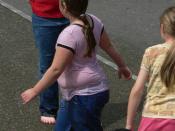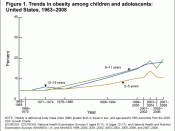IntroductionChildhood Obesity is growing problem in the United States. Between 5-25 percent of children and teenagers in the United States are obese (Dietz, 1983). This increasing percentage has brought into the light the problem of childhood obesity. Children are growing fatter younger. The second National Children and Youth Fitness Study found that 6-9 year olds have thicker skinfolds compared to their counterparts in the 1960s (Ross & Pate, 1987). During the same period, some have documented a 54 percent increase in the frequency of obesity among 6-11 year olds (Gortmaker, Dietz, Sobol, & Wehler, 1987). The prevalence of obesity increases with age among both males and females (Lohman, 1987), and there is a greater likelihood that obesity beginning in early childhood will last throughout a life span (Epstein, Wing, Koeske, & Valoski, 1987). So while an obese baby may not become an obese child and an obese child may not become an obese adult, the likelihood increase and may last a lifetime.
It is safe to say that childhood obesity is an issue that needs to be explored.
Defining Childhood ObesitySo what is childhood obesity? Obesity, by itself, is defined as an excessive accumulation of body fat. Obesity is obtained when total body weight is measured as having more than 25 percent fat in boys and more than 32 percent fat in girls (Lohman, 1987). However, it is different in the case of children. Childhood obesity is defined as a weight-for-height in excess of 120 percent of the ideal. Because of growing differences between ages and gender, skinfold measurement would be more accurate determinant of fatness in the case of children (Dietz, 1983; Lohman, 1987).
Dangers of Childhood ObesityWhat are the dangers of childhood obesity? As stated before, the likelihood of being obese as an adult drastically increases when...


